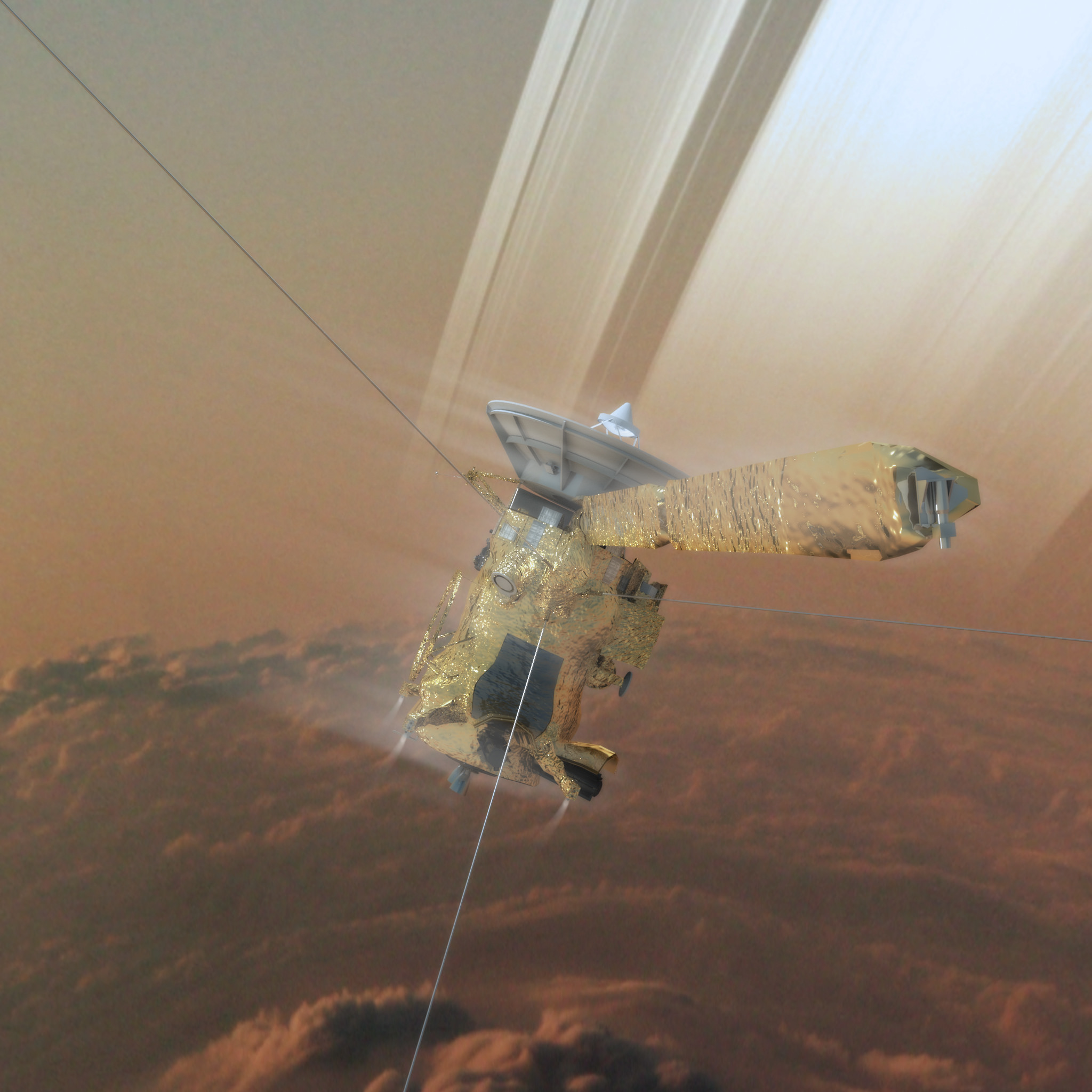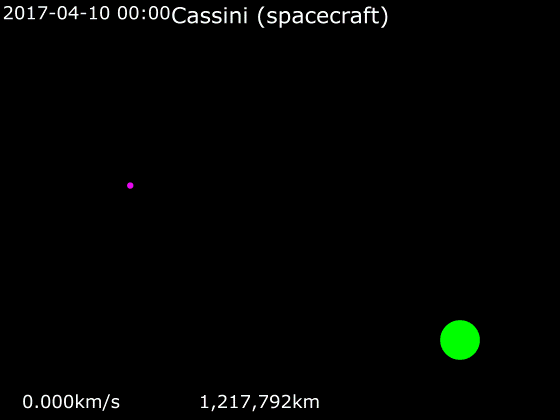Cassini-Huygens retirement on:
[Wikipedia]
[Google]
[Amazon]
 The '' Cassini''
The '' Cassini''

 On July 4, 2014, the ''Cassini'' science team announced that the proximal orbits of the probe would be named the "Grand Finale". This would be immediately preceded by a gradual shift in inclination to better view Saturn's polar hexagon, and a flyby of
On July 4, 2014, the ''Cassini'' science team announced that the proximal orbits of the probe would be named the "Grand Finale". This would be immediately preceded by a gradual shift in inclination to better view Saturn's polar hexagon, and a flyby of 
''Cassini-Huygens''
at
''Cassini-Huygens'' main page
at
''Cassini'' Mission Homepage
by the
''Cassini-Huygens'' Mission Profile
by NASA's Solar System Exploration
''Grand Finale'' Overview
at
 The '' Cassini''
The '' Cassini'' space probe
A space probe is an artificial satellite that travels through space to collect scientific data. A space probe may orbit Earth; approach the Moon; travel through interplanetary space; flyby, orbit, or land or fly on other planetary bodies; or ...
was deliberately disposed of via a controlled fall into Saturn's atmosphere on September 15, 2017, ending its nearly two-decade-long mission
Mission (from Latin ''missio'' "the act of sending out") may refer to:
Organised activities Religion
*Christian mission, an organized effort to spread Christianity
*Mission (LDS Church), an administrative area of The Church of Jesus Christ of ...
. This method was chosen to prevent biological contamination of any of the moons of Saturn now thought to offer potentially habitable environments. Factors that influenced the mission end method included the amount of rocket fuel left, the health of the spacecraft, and funding for operations on Earth.
Some possibilities for ''Cassini'' later stages were aerobraking into orbit around Titan, leaving the Saturn system, or making close approaches and/or changing its orbit. For example, it could have collected solar wind
The solar wind is a stream of charged particles released from the upper atmosphere of the Sun, called the corona. This plasma mostly consists of electrons, protons and alpha particles with kinetic energy between . The composition of the sol ...
data in a heliocentric orbit.
End of mission options
During planning for its extended missions, various future plans for ''Cassini'' were evaluated on the basis of scientific value, cost, and time. Some of the options examined included collision with Saturn atmosphere, an icy satellite, or rings; another was departure from Saturn orbit toJupiter
Jupiter is the fifth planet from the Sun and the largest in the Solar System. It is a gas giant with a mass more than two and a half times that of all the other planets in the Solar System combined, but slightly less than one-thousandth t ...
, Uranus
Uranus is the seventh planet from the Sun. Its name is a reference to the Greek god of the sky, Uranus ( Caelus), who, according to Greek mythology, was the great-grandfather of Ares (Mars), grandfather of Zeus (Jupiter) and father of ...
, Neptune, or a centaur. Other options included leaving it in certain stable orbits around Saturn, or departure to a heliocentric orbit. Each plan required certain amounts of time and changes in velocity. Another possibility was aerobraking
Aerobraking is a spaceflight maneuver that reduces the high point of an elliptical orbit ( apoapsis) by flying the vehicle through the atmosphere at the low point of the orbit ( periapsis). The resulting drag slows the spacecraft. Aerobraking ...
into orbit around Titan.
This table is based on page 19 of ''Cassini Extended Missions'' (NASA), from 2008.
Atmospheric entry and destruction

 On July 4, 2014, the ''Cassini'' science team announced that the proximal orbits of the probe would be named the "Grand Finale". This would be immediately preceded by a gradual shift in inclination to better view Saturn's polar hexagon, and a flyby of
On July 4, 2014, the ''Cassini'' science team announced that the proximal orbits of the probe would be named the "Grand Finale". This would be immediately preceded by a gradual shift in inclination to better view Saturn's polar hexagon, and a flyby of Enceladus
Enceladus is the sixth-largest moon of Saturn (19th largest in the Solar System). It is about in diameter, about a tenth of that of Saturn's largest moon, Titan. Enceladus is mostly covered by fresh, clean ice, making it one of the most refle ...
to more closely study its cryovolcanism
A cryovolcano (sometimes informally called an ice volcano) is a type of volcano that erupts volatiles such as water, ammonia or methane into an extremely cold environment that is at or below their freezing point. The process of formation is know ...
. This was followed by a dive into Saturn's atmosphere.
There was budgetary drama in 2013–14 about NASA receiving U.S. government funding for the Grand Finale. The two phases of the Grand Finale ended up being the equivalent of having two separate Discovery Program-class missions in that the Grand Finale was completely different from the main ''Cassini'' regular mission. The U.S. government in late 2014 approved the Grand Finale at the cost of $200 million. This was far cheaper than building two new probes in separate Discovery-class missions.
Scientific data was collected using eight of its twelve science instruments. All of the probe's magnetosphere and plasma science instruments, plus the spacecraft's radio science system, and its infrared and ultraviolet spectrometers collected data during the final plunge. The data rates flowing back from Saturn could not support imaging during the final plunge, so all pictures were downlinked (transmitted back to Earth) and cameras were switched off, before the final plunge began. The predicted altitude for loss of signal was approximately above Saturn's cloud tops, when the spacecraft began to tumble and burn up like a meteor.
''Cassini''s final transmissions were received by the Canberra Deep Space Communication Complex
The Canberra Deep Space Communication Complex (CDSCC) is a satellite communication station, part of the Deep Space Network of NASA's Jet Propulsion Laboratory (JPL), located at Tidbinbilla in the Australian Capital Territory. Opened in 1 ...
, located in Australia at 18:55:46 AEST. In a bittersweet ending for the scientists involved, some of whom had been involved in the mission for decades, data was received for 30 seconds longer than anticipated, and the spacecraft's ultimate demise was predicted to have occurred within 45 seconds after that. Homages were paid on social media. NASA's video won an Emmy for "Outstanding Original Interactive Program".

See also
*Deliberate crash landings on extraterrestrial bodies
These are tables of space probes (typically orbiters or components thereof) which have been deliberately destroyed at their objects of study, typically by hard landings or crash landings at the end of their respective missions and/or functiona ...
* Timeline of ''Cassini–Huygens''
References
Further reading
*External links
''Cassini-Huygens''
at
ESA
, owners =
, headquarters = Paris, Île-de-France, France
, coordinates =
, spaceport = Guiana Space Centre
, seal = File:ESA emblem seal.png
, seal_size = 130px
, image = Views in the Main Control Room (120 ...
''Cassini-Huygens'' main page
at
NASA
The National Aeronautics and Space Administration (NASA ) is an independent agencies of the United States government, independent agency of the US federal government responsible for the civil List of government space agencies, space program ...
''Cassini'' Mission Homepage
by the
Jet Propulsion Laboratory
The Jet Propulsion Laboratory (JPL) is a federally funded research and development center and NASA field center in the City of La Cañada Flintridge, California, United States.
Founded in the 1930s by Caltech researchers, JPL is owned by NASA an ...
''Cassini-Huygens'' Mission Profile
by NASA's Solar System Exploration
''Grand Finale'' Overview
at
NASA
The National Aeronautics and Space Administration (NASA ) is an independent agencies of the United States government, independent agency of the US federal government responsible for the civil List of government space agencies, space program ...
{{DEFAULTSORT:Cassini-Huygens retirement
Cassini–Huygens
Spacecraft endings
Extraterrestrial atmosphere entry
2017 in spaceflight